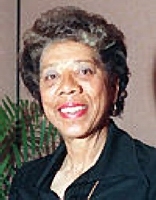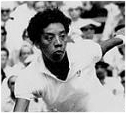
|
|
Believe in yourself
|
|
Exercise
A
A1 All of us are born within social roles that define what society expects of us. What were the social roles expected of Anthea? Which ones of these did she need to escape from?A2 In the song quoted below, Sidney Carter speaks of ‘masks’ when describing social roles. Why? What is the meaning of his song?I wore the mask of a baby I wore the mask of a schoolboy I wore the mask of a soldier I wore the mask of a man in love I wore the mask of a married man They’ll ring the bell for a dead man Song by Sidney Carter A3. [personal exercise] |
narration1. 1 Stepping out of unjust social rolesAlthea Gibson was born August 25, 1927, in Silver, South Carolina, USA. She was the eldest of five children. A self-described “born athlete”, she picked up tennis while growing up in New York, slapping rubber balls off a brick wall.Would she be able to compete? And compete against whites? After all, she came from a poor neighbourhood, was only a woman and also black. At that time women were just beginning to gain equal rights in many areas of public life. And Blacks - African Americans - were still racially segregated in many parts of the USA as second-class citizens.
To enter competitions on city and state level required a lot of courage. Gibson decided to go ahead regardless of the opposition she was to face. She believed in her self dignity. Gibson won her first tournament at 15, becoming the New York State black girls’ champion. Boxer Sugar Ray Robinson, who was black himself, helped pay her traveling expenses. “No one publicly said anything against me”, Gibson said, “because I carried myself with dignity. Tennis was a game for ladies and gentlemen, and I conducted myself in that manner.” She attended Florida Amateurs & Masters on a tennis and basketball scholarship and then began her ascent in the American Tennis Association, founded in 1916 for black players. Fran Gray a long-time friend once stated: “Althea proved herself in a hard time. Segregation was no easy thing to break. It was a feat which she accomplished under really devastating and debilitating odds because she wasn’t wanted. Her contribution to the civil rights movement was done with her tennis racket”. |
|
Exercise
B
B1 All of us are born with traits and features that we cannot change, such as our nationality, our body, our temperament, and so on. We are not born with ‘character’. Our ‘character’ is formed by our own decisions, by our actions in the face of conflict or opposition, by overcoming problems. How did Althea Gibson build her character?B2 Frequently we see lack of ‘character’ in people. Can you comment on the following expressions?
B3. [personal exercise] |
1. 2 Building your characterIn the beginning Althea Gibson was often defeated. Disappointed by her early showings at major tournaments, she thought about quitting tennis and entering the Army in 1955. She went through a real crisis.She had to take difficult decisions. She had to believe in herself and her gifts. She had to make up her mind that she really wanted to win in spite of all obstacles and setbacks. Crisis often helps to build character if we resolutely face it. It proved crucial to Gibson’s ultimate success. Success came a year later. She blossomed during a nine-month tour sponsored by the U.S. State Department, winning 14 of 17 tournaments and reaching the finals of the other three. In 1950, Althea Gibson became the first black player to compete at the national tennis championship - the precursor to the U.S. Open. She went to the international tournament at Wimbledon, England, in 1951. Her first major singles title came in 1956 at the French Open, and she won both Wimbledon and the U.S. Open in 1957-58! The 5-foot-11 Gibson used an attacking serve-and-volley style to dominate women’s tennis from 1956-58, winning 11 Grand Slam titles: five in singles, five in doubles, one in mixed doubles. Tennis player Althea Gibson was named Woman Athlete of the Year in 1957 and 1958. Althea Gibson was named Woman Athlete of the Year in 1957 and 1958. That began her run of greatness, and she was the Associated Press' Female Athlete of the Year in 1957 and 1958. After her 1957 Wimbledon victory, she was given a parade in New York City. More than 30 years passed before another black woman, Zina Garrison, would reach the Wimbledon final, in 1990.
“Who could have imagined? Who could have thought?”, Gibson said as she presented her Wimbledon trophies to the Smithsonian Institution in 1988. “Here stands before you a Negro woman, raised in Harlem, who went on to become a tennis player ... in fact, the first black woman champion of this world”, she said. |
|
Exercise
C
C1 When Althea Gibson died, famous tennis champions paid tribute to her. Do you think they did full justice to her character?Martina Navratilova, who won hundreds of tennis titles said:
Billie Jean King, a Grand Slam champion who helped found the Women's Tennis Association, was 13 when she first saw Gibson play.
Venus Williams, world tennis champion number one during a number of years stated:
C2. [personal exercise]
|
If you want to obtain a certificate for this leadership course, register yourself by sending an email to Jos Rickman at the address given below. Mention (i) your name, (ii) your country, (iii) your email and (iv) the name of this course. And (v) attach a short document containing your answers to exercises A1, A2, B1, B2, C1 & C2 of this lesson. |
Althea Gibson helped pave the way for later black stars such as Arthur Ashe, Venus and Serena Williams, and Tiger Woods.
But Gibson played in an era without big paychecks for pros at major tennis tournaments or endorsement deals for athletes. Instead, she tried to earn a living other ways, recording an album, appearing in a movie, and getting paid for playing tennis exhibitions on tour with the Harlem Globetrotters.
After retiring from tennis, she turned to women’s golf, again as one of the first black competitors, playing in 171 tournaments from 1963-77, without ever winning a title. In and out of competition, she was a role model for many.
 In 1975, Gibson became state commissioner
of athletics in New Jersey. She then served on the state athletics control
board until 1988, and as a member of the governor’s council on physical
fitness until 1992.
In 1975, Gibson became state commissioner
of athletics in New Jersey. She then served on the state athletics control
board until 1988, and as a member of the governor’s council on physical
fitness until 1992.
Gibson was married twice. Husbands William Darben and Sidney Llewellyn both died before she did. She didn’t have children.
With her friend Fran Gray she founded the Althea Gibson Foundation, which helps urban youths learn to play tennis and golf.
In recent years, Gibson had two cerebral aneurysms and a stroke, and she struggled financially. When news of her situation spread in 1996, letters with donations poured in, including one with $200 from Mariaan de Swardt, a South African tennis player. “I focused on your game when I learned how to play, and I wanted to thank you”, a note from de Swardt read.
As health problems plagued Gibson in recent years, she isolated herself and spoke to few people. She didn’t attend a ceremony marking her 75th birthday at last year’s U.S. Open or the 1997 dedication of that tournament's new Arthur Ashe Stadium.
 |
 |
 |
 |
 |
| 1. Self Respect | 2. Integrity | 3. Study | 4. Doubt | 5. Generosity |